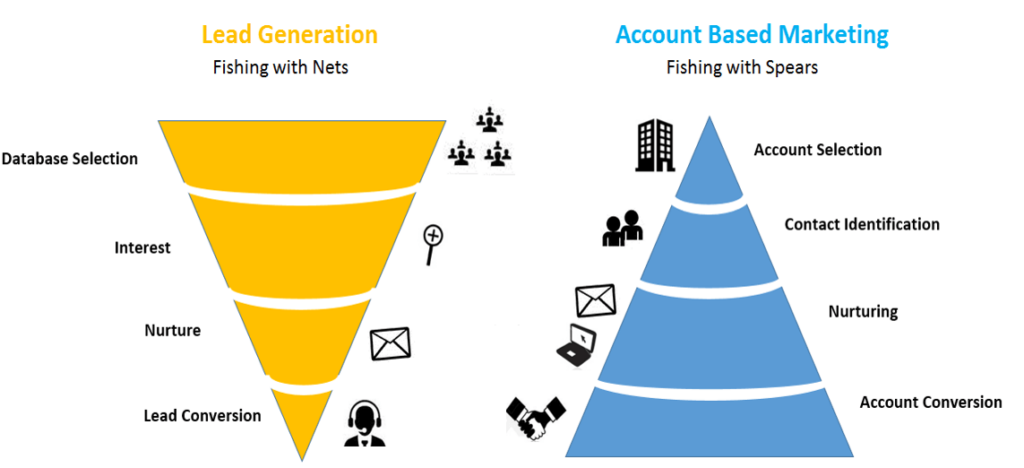Two of the most common inbound marketing strategies for B2B marketing are account-based marketing (ABM) and lead generation.
But which one is right for your business?
While an account-based marketing strategy prioritizes a targeted approach for high-value accounts, traditional lead generation casts a wide net to capture as many prospects as possible.
In this article, we'll break down the key differences and similarities between ABM and lead generation marketing tactics to help you decide which strategy will drive better results for your business.
What Is Account-Based Marketing?
Before getting into the nitty gritty, let’s zoom out: what is ABM?
With an account-based marketing strategy, you design marketing campaigns to appeal to a specific account or individual prospect. While there are different types of ABM, the general ABM framework involves leveraging customer data to create highly targeted campaigns that speak directly to your prospect, driving brand awareness and demonstrating why your product or service is the best solution for their specific pain points.
What Is Lead Generation?
Lead generation involves attracting potential customers to your business and nurturing their interest to turn them into actual customers. It focuses on sparking interest in a product or service to convert prospects into buyers.
"Reduce the risk [of an empty pipeline] by having multiple channels to drive leads," says Alexandre Boudier, Director of Growth at Solink. "It’s best to have a layered approach to B2B lead generation, where each layer is a channel/strategy combination."
Boudier continues, "You also want each layer to be as stable as possible and to keep growing. This can only be achieved by diversifying your sources of leads and being creative."
ABM vs. Lead Generation: Differences & Similarities
Let’s take a look at some of the similarities and differences between account-based marketing and lead generation:
| Differences | Similarities | ||
| Account-Based Marketing (ABM) | Lead Generation | ||
| Audience | Targets specific, high-value accounts. | Broad audience to capture as many leads as possible. | Both aim to attract potential customers. |
| Strategy | Personalized campaigns for individual accounts. | Mass campaigns to generate a large number of leads. | Both require strategic planning for audience engagement. |
| Messaging Approach | Tailored, highly personalized messages for specific accounts. | Generalized messaging for wide appeal. | Both use persuasive messaging to influence potential buyers. |
| Channels | Focus on high-touch, multi-channel outreach. | Uses broad digital channels like social media and email. | Both use multiple marketing channels to reach their audience. |
| Customer Focus | Focuses on existing customers or high-value prospects. | Focuses on acquiring new leads and potential customers. | Both work towards converting prospects into customers. |
| Success Metrics | Measured by account engagement and deal size. | Measured by the number of leads generated and conversion rates. | Both rely on data to evaluate effectiveness. |
Account-Based Marketing vs. Lead Generation: Differences
The following graphic illustrates the fundamental differences between ABM and lead generation. While ABM starts out with a narrow focus, taking time to identify high-value accounts and taking a strategic approach toward developing a precise marketing strategy, lead generation casts a wider net to maximize demand generation, regardless of the quality of leads or their lifetime value for the business.

Let’s take a closer look at some of the key differences between ABM and lead generation.
1. ABM Focuses On Quality, Lead Generation Focuses On Quantity
ABM focuses on high-quality leads and targeted accounts that fit your company’s ideal customer profile (ICP). Lead generation initiatives aim to capture as many leads as possible regardless of account quality.
Building an ROI-focused ABM campaign for enterprise-level clients like Fortune 500 companies requires personalized ABM segmentation strategies, while lead generation for a SaaS startup might involve attracting thousands of potential users via social media ads on LinkedIn.
2. ABM Targets High-Value Deals, While Lead Generation Focuses on Volume
ABM pursues large, high-value deals, often with enterprise clients. In contrast, lead generation seeks to fill the sales pipeline, focusing on volume rather than deal size or return on investment.
A B2B company using ABM might invest months into closing one large contract with a multinational firm. In contrast, an e-commerce company relies on lead generation to sell products to a broader audience without concern for developing customer relationships or delivering personalized experiences.
3. ABM Aligns Marketing and Sales, While Lead Generation Often Means Marketing and Sales Operate in Silos
ABM requires close collaboration between marketing and sales, ensuring a unified effort to target and engage specific accounts. Lead generation often sees marketing and sales working independently, with marketing handing over leads to sales.
Under the ABM model, your sales team actively collaborates with marketers to nurture key accounts through the sales funnel. A marketing team using lead generation might send hundreds of unqualified leads to sales with minimal collaboration.
4. ABM Influences the Buying Committee, While Lead Generation can Sometimes Chases Vanity Metrics
The core ABM metrics focus on successfully influencing multiple stakeholders within a single organization. It aims to engage decision-makers directly. Lead generation, in contrast, might prioritize vanity metrics like total leads or social media engagement without consideration for decision-making influence.
A tech company using ABM might tailor content for key decision-makers, such as IT managers, CFOs, and procurement. A lead generation campaign might celebrate a high number of form fills, even if it doesn’t result in qualified leads that influence purchasing decisions.
5. ABM Involves Longer Sales Cycles While Lead Generation Seeks Faster Conversions
ABM targets larger accounts requiring more touchpoints, typically meaning longer sales cycles. Lead generation tends to focus on shorter sales cycles, aiming for quicker conversions from a wider audience.
ABM in the software industry might take months to close a deal with a government agency, whereas lead generation could quickly convert leads for a low-cost, self-serve SaaS product.
6. ABM Delivers Personalized Content, While Lead Generation Relies on Generic Messaging
An ABM content strategy hinges on personalized content that addresses each target account’s specific needs and pain points. Lead generation involves more generalized content marketing, one designed to appeal to a broader audience.
Under the ABM model, you might create a tailored whitepaper addressing a specific prospect’s industry challenges, while lead generation campaigns often use downloadable eBooks or webinars aimed at a wide range of users.
Investing in the right account-based marketing software is necessary if you’re eager to reel in those high-value target accounts. Check out our comprehensive guide to the best ABM software for 2025.
Account-Based Marketing vs. Lead Generation: Similarities
1. Both ABM and Lead Generation Require a Defined Buyer Journey
Both account-based marketing and lead gen involve mapping out a straightforward buyer journey to guide potential customers from awareness to purchase. Understanding how your ideal customer profiles move through the stages of consideration and decision-making is key to nurturing them effectively.
Whether you're using ABM to nurture a specific account or lead generation to convert multiple prospects, you need to define touchpoints and provide content that aligns with the buyer's journey.
2. ABM and Lead Generation Both Require an Understanding of the Target Audience
Both ABM and lead generation rely on a deep understanding of your target audience to be successful.
ABM focuses on developing a solid understanding of a specific account's organizational structure to deliver personalized outreach. Lead generation prioritizes a broader understanding of customer demographics to craft messaging with mass appeal.
Although the personalization approach may differ, both strategies require insight into a prospect’s pain points, preferences, and behaviours to tailor messaging effectively.
3. ABM and Lead Generation Share the Same Goals
At their core, both ABM and lead generation strategies share the common goal of driving revenue and acquiring new customers. Whether through a personalized ABM strategy to close a significant deal or a large-scale lead generation campaign to attract small business owners, the ultimate aim is to increase sales and grow the business.
Despite their different approaches, they both seek to convert prospects into paying customers.
Account-Based Marketing vs Lead Generation: Which is Best For You
The right choice depends on your business goals and resources.
ABM is best for companies seeking long-term relationships with fewer, high-revenue clients. ABM personalization is resource-intensive but can deliver significant returns through larger deals. If you're targeting high-value, enterprise-level accounts and have a strong alignment between marketing and sales, account-based marketing is ideal.
On the other hand, if you’re focused on scaling quickly by generating as many potential customers as possible, lead generation is the better option. This strategy works well for businesses with shorter sales cycles, lower-cost products, or a broad customer base. With lead generation, you can fill your pipeline quickly and drive quick conversions, making it an excellent option for companies with a self-serve or volume-driven model.
In short, choose ABM if you focus on quality and lead generation if quantity is key. Depending on their product offerings and market segments, some businesses even combine both marketing approaches.
Join For More ABM Insights
Looking to learn more about ABM and how it supports your overall B2B marketing strategy? Subscribe to The CMO newsletter to stay on top of ABM trends and get the latest tips, resources, and guides from our community of seasoned marketing leaders straight to your inbox.



